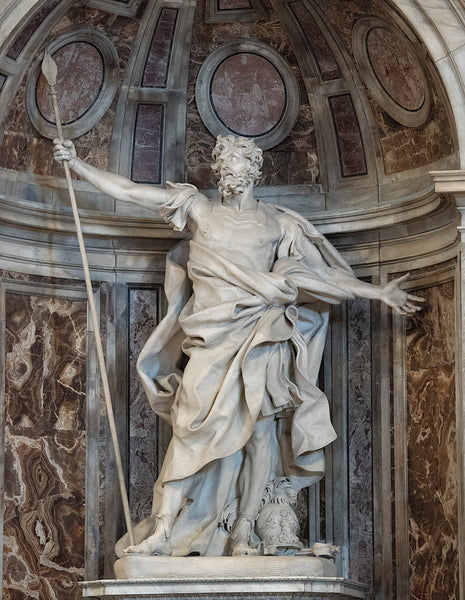Exploring Bernini and His World - by Livio Pestilli
'After all that has been written about Gian Lorenzo Bernini over the last several decades, do we need or want another book about him? The answer is simple: If that book offers new ways of thinking about and new insights into Bernini as an artist, about his approach to sculpture, about the Rome in which he lived and its reception to foreign sculptors, about the myth-making aspects of his biographies, and about his legacy, then it would be a welcome addition to the literature. And Livio Pestilli has written just such a book—one that offers new perspectives on and fresh insights about all of these topics. It is, simply, a smart, eminently readable, engaging book, from which readers will learn a great deal about Bernini and his world. Pestilli has a thorough command of the scholarly literature and classical literary traditions; a sensitivity to images and texts; a deep familiarity with Italian culture, both historical and modern; and a clarity of thought and verbal expression. Each of the chapters of his book can be read as a self-contained essay, but all six cohere to paint a vivid and wide-ranging picture of sculpture and sculptors, especially Bernini, in early modern Rome.'
- Steven F. Ostrow, Professor of Art History, University of Minnesota

PREFACE
An astounding feature of seventeenth- and early eighteenth-century Roman art is the plethora of sculptural works that fill the city’s numerous churches and museums. A visit to a single venue in the Eternal City is sufficient evidence of the sculptors’ copious output during this period: the church of Sant’Agnese in Agone. Even the ‘accidental tourist’ who walks into what was basically the Pamphili family private chapel in Piazza Navona cannot be but struck by the fact that all seven altars in this house of prayer are graced with sculptures rather than paintings. But a jaunt to any other church in the heart of the Holy City by the discerning art lover will only reinforce the perception that the sculptors working at that time had vast employment opportunities. Indeed, echoing Cassiodorus’ advice to the city’s prefect to hire an architect for the preservation of Rome’s statues – ‘an artificial population almost equal to its natural one’ – Leopoldo Cicognara noted in his history of Italian sculpture how ‘a population of statues decorated all of these sacred edifices’.1 In fact, during this period, scores of marble workers from different parts of Italy and north of the Alps were attracted to Rome in search of work and fame. None, however, was so successful in giving his personal artistic imprint to the city as did Gian Lorenzo Bernini.2 As the recipient of the most important papal and private commissions, Bernini astounded his contemporaries by prodigious carving skills that allowed him to quickly rise to the top of his professional and social pyramid. Looking at any of his sculptures, one can easily understand why already during his lifetime he was considered the new Michelangelo. Of course, there were other contemporary sculptors who produced great works of art, but it would not be inaccurate to claim that Baroque Rome is ultimately ‘Bernini’s Rome’. [...]

Even though sculpture is the common denominator of this book, the impetus to write it arose from a desire to study the artist and the context in which he worked through different ‘lenses’. Thus, while loosely retaining a chronological progression that follows the artist from ‘the cradle to the grave’, I have chosen to treat the subject typologically; that is, I have concentrated on themes that, by taking Bernini as their starting point, shed a light on the wider artistic context. However, it should be clear from the outset that the book is not just about Bernini, nor is it limited to subjects and events that relate strictly to his lifetime. Rather, it is a study that looks at social and anthropological themes that expand our horizon on the subject; it looks to the past as well as to the period following Bernini’s death to better understand his world, the mythopoeic efforts of his biographers, and the influence he exerted on other artists.
Thus, in the first chapter, ‘Berninus Neapolitan[us] sculptor’, I choose to address a socio-anthropological bias present in seventeenth-century Italy that helps us understand why Bernini, though born in Naples, preferred to refer to himself as a Florentine or a Roman. Besides the artist’s personal and artistic reasons for claiming allegiance to Florence or Rome, the study reveals how deep-seated geographical and ethnic biases vis-à-vis southerners, in general, and Neapolitans, in particular, were prevalent not just on Italian soil, but in Europe at large, and further assesses to what extent Bernini was truly a ‘Neapolitanus sculptor’.
In Chapter 2, ‘Of Sculptors and Cobblers’, I focus on the basic psychological change in approach to sculpture that evolved from the sixteenth to the seventeenth centuries. Given the deference artists and intellectuals had towards the classical tradition and their misconceived notion that in antiquity the sculptors’ ultimate challenge was represented by a marble sculpture executed out of one marble block (ex uno lapide), the chapter considers the socio- artistic background that led to the acceptance of what became a ‘trademark’ of Baroque sculpture: figures composed of multiple blocks. In the light of Renaissance prejudices with regard to those sculptors who, in restoring fragments of ancient statues, ‘patched’ them by the addition of the missing parts so as to make them ‘whole’, or who, in the execution of their own sculptures, added pieces to the core of the statue, this chapter raises the question as to why these artists were derogatorily labeled as ‘cobblers’. Paradoxically, it is argued, it was only when marble carvers became ‘cobblers’ that the new Baroque sculptural style came into its own.
In Chapter 3, ‘Tall Tales’, the attention is shifted from sculptures to the literary tradition. While analyses of artists’ biographies from antiquity to the Renaissance have been ‘mined’ for more than factual information, at least since the publication of Ernst Kris and Otto Kurz’s Legend, Myth, and Magic in the Image of the Artist, a similar line of investigation with regard to seventeenth- and eighteenth-century sources has been relatively scarce. It was not until recently that the most significant collection of essays on the subject with regard to Bernini was finally published. Edited by Maarten Delbeke, Evonne Levy, and Steven F. Ostrow, Bernini’s Biographies: Critical Essays (2006) is a landmark in such inquiries that finally brought attention to the subtle ways in which Filippo Baldinucci’s and Domenico Bernini’s biographies, in the wake of Vasari’s Lives, spun stories that reveal the authors’ multiple agendas. This chapter of my book sheds further light on a number of anecdotes narrated by the two authors that I believe needed further elucidation and are exposed for what they are: anecdotal fabrications.
Chapter 4 is the ‘sibling’ of the previous chapter but it is fully devoted to a leitmotif present in biographies of artists that has received insufficient consideration in contemporary studies. ‘Biographies, Garments, and Bernini’s “Abito . . . grosso, e rozzo” in Perspective’ traces the way in which sartorial details – which in antiquity were occasionally employed to distinguish artists with a claim to higher manual ability and social status – by the Renaissance and the Baroque had become a fixed feature and a crowning aspect of the artists’ Lives. Frequently used as signs of the artists’ compliance with societal mores, garments were also employed to extol or denigrate an individual and indicate an artist’s specific profession or morality. It is through the inquiry of the historical significance vestments acquired through the ages that the biographers’ single mention of Bernini’s attire – his sculptor’s ‘heavy rough garment’ – may be fully appreciated.

‘Pride and Prejudice: Paris–Rome’, the subject of Chapter 5, seeks to investigate the dynamics generated by the juxtaposition of artists of different nationalities when working within the same context. Thus, by taking Bernini’s negative experience in Paris, vis-à-vis French artists and critics as a starting point, this chapter looks at the way foreign artists were conversely regarded and treated in Rome from the sixteenth through the early eighteenth century. Proceeding from more general to specific assessments of circumstances in which potential tensions between Italian and foreign artists – and sculptors in particular – could have surfaced, this section of the book focuses on the transnational character of the Eternal City that made it a unique artistic laboratory in early modern Europe. To corroborate the analysis, the chapter further looks at three ‘case studies’ and epistolary documentation from a historical juncture when Rome gradually ceded the scepter to Paris as the leading European artistic center. The ancillary theme of this chapter is a consideration of Rome’s acclaimed cosmopolitanism in the ‘tug-of-war’ with Paris over artistic and cultural supremacy.
The sixth and final chapter, ‘Bernini’s Shadow’, considers the persistent influence Bernini had on generations of sculptors and art lovers through much of the eighteenth century. Contrary to a traditional belief that Gian Lorenzo Bernini’s critical fortune waned by the turn of the century, through the analysis of epistolary and institutional records – such as those of the Académie de France and the Accademia di San Luca – as well as the visual, artistic production of the period, this chapter provides ample proof that such an interpretation is the result of strabismic hindsight. For Bernini’s compositional innovations and personal carving style left their mark on future generations of artists right to the end of the eighteenth century and are readily verifiable by visiting many Roman churches.
It is hoped that the kaleidoscopic approach here employed will contribute, for those familiar with the subject, to a heightened understanding of Bernini and his world, and, for readers less conversant with the artist, to a greater interest in one of the most outstanding periods in early modern sculpture. Simply stated, this volume represents another ‘brick in the wall’ of the common house that unites, under one roof, art lovers of Baroque Rome and its most representative artist.
Bernini and His World by Livio Pestilli will be released on 21st March 2022.
Pre-order your copy HERE.
Images:
Fig 1 - Gian Lorenzo Bernini, Saint Longinus, 1635-8, marble, Saint Peter’s Basilica, Rome. Photo: Livio Pestilli
Fig 2 - Gian Lorenzo Bernini, Saint Bibiana, 1624, marble, Santa Bibiana, Rome. Photo: Daniele Martini
Fig 3 - Gian Lorenzo Bernini, Apollo and Daphne, 1625, Galleria Borghese, Rome. Photo: Luciano Romano. Courtesy of Borghese


